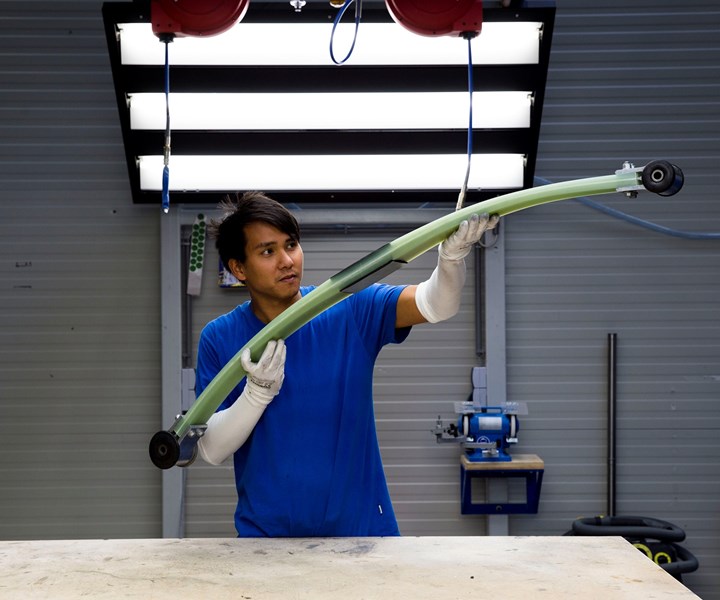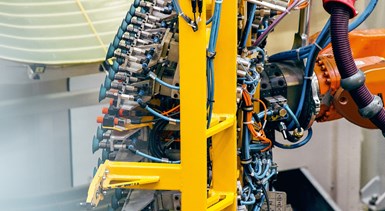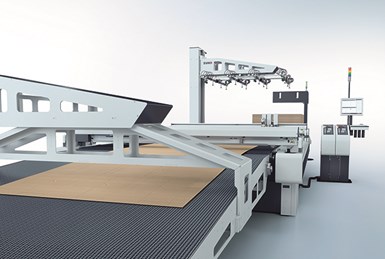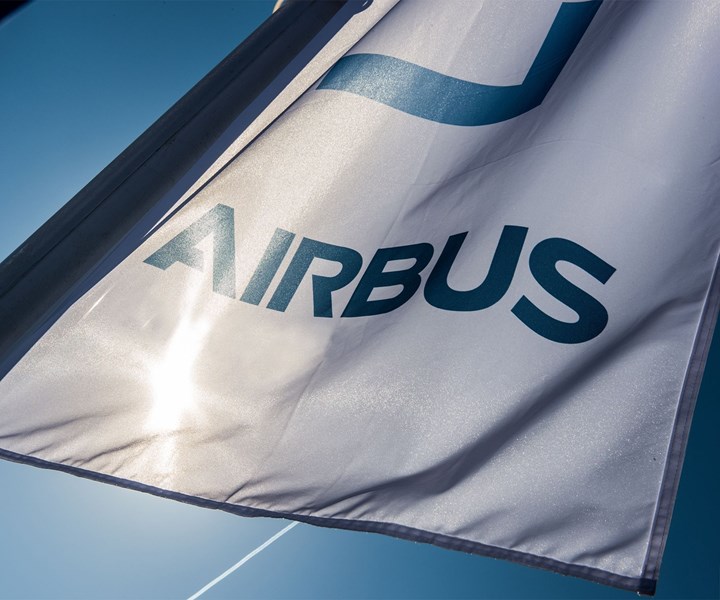CompositesWorld News for Dec. 11, 2019
Read news from Magma Structures BP, ELG Carbon Fibre, SGL Carbon SE, Gardner Business Intelligence, Zund America, and Albany Engineered Composites
Carbon fiber composite rail bogie unveiled
The CAFIBO rail bogie is constructed from recycled and surplus carbon fiber and was developed by ELG Carbon Fibre and partners.

Source | ELG Carbon Fibre Ltd.
On Dec. 10, the world’s first carbon fiber rail bogie (called CAFIBO) was officially unveiled by developer ELG Carbon Fibre (Coseley, U.K.) and collaborator the University of Huddersfield’s Institute for Railway Research.
The bogie, which is made entirely out of surplus and recycled carbon fiber materials (see CW’s feature on the bogie’s design), was presented to more than 100 industry delegates at the Railway Industry Association’s (RIA) Unlocking Innovation event at the University of Huddersfield.
The new CAFIBO bogie is reportedly lighter than conventional bogies, and optimizes vertical and transverse stiffness. This bogie will:
- reduce track wear and infrastructure maintenance costs by reducing vertical and transverse loads on the rails,
- improve reliability and operational availability through an embedded health monitoring system, and
- reduce energy consumption and hence global warming footprint.
The bogie is being developed as part of a two-year program delivered by consortium ELG Carbon Fibre, Magma Structures (Portsmouth, U.K.), the University of Birmingham and the University of Huddersfield with additional support from Alstom (London, U.K.). Over the next few months, the bogie will be tested on the University of Huddersfield’s state-of-the-art test rolling rig named the Huddersfield Adhesion & Rolling contact Laboratory Dynamics rig, or ‘HAROLD.’
“Replacing steel with recycled carbon fiber to produce a rail bogie is a world first so it is a hugely exciting and rewarding project to be part of,” says Frazer Barnes, managing director of ELG Carbon Fibre. “We hope to make recycled carbon not only an attractive option for the rail industry in terms of weight reduction but also to eliminate waste and drive down cost.”
“There are significant potential benefits from adopting novel materials and construction methods in railway vehicle bogies,” says Simon Iwnicki, director of the Institute of Railway Research at the University of Huddersfield. “The reduction in mass results in energy savings but can also reduce track forces and improve dynamic performance. I hope that the tests on the CAFIBO bogie being carried out here at Huddersfield will help to encourage the railway industry to accept these new techniques.”
SGL Carbon produces composite leaf springs for Ford Transit
The glass fiber composite, longitudinal leaf springs are said to weigh 50% less than conventional steel springs.

Source | SGL Carbon
SGL Carbon (Wiesbaden, Germany) announced on Dec. 11 that it is producing glass fiber composite, longitudinal leaf springs for Ford Transit rear axles in series. This is Ford’s first leaf spring project with composites in series worldwide.
The springs, intended for use with the Transit Skeleton chassis, are designed for high payloads and increased security standards, though are said to weigh about 50% less than conventional steel leaf springs. The serial application is supported by a one-to-one compatibility with standard steel springs.

Source | SGL Carbon
According to SGL Carbon, these leaf springs are the first to be manufactured with pre-impregnated glass fiber fabrics, which are produced at the SGL Carbon site in Willich, Germany. The SGL Carbon component plant in Innkreis, Austria, is responsible for the development and serial production of the springs, and the final products are delivered ready to install to the Ford-Otosan assembly plant in Kocaeli, Turkey.
“The design of these composite longitudinal leaf springs for the Ford Transit Skeleton chassis is yet another milestone in the development of production-ready lightweight leaf springs. They are not only characterized by their special material properties and semi-automatic production, but especially by their high compatibility with various customer model variants,” says Sebastian Grasser, head of the Automotive Composites – Fibers & Materials business unit at SGL Carbon.
Webinar to discuss 2020 automotive market
Chief economist Michael Guckes and Gary Vasilash, editor of sister publication Automotive Design & Production, will host a webinar on Dec. 17.

What’s in store for the automotive industry in 2020?
In a webinar to take place Dec. 17, 2019 at 11:00 a.m. ET, Gary Vasilash of sister publication Automotive Design & Production and Michael Guckes of Gardner Intelligence will use their deep knowledge of the automotive industry to discuss where the industry has been and what may be in store for the industry in 2020.
The primary topics will be:
- What major events will impact the industry in 2020?
- What is the Gardner Business Index telling us about the health of the Automotive supply chain?
- What does the macroeconomic data tell us about the market?
Michael Guckes is the chief economist/director of analytics for Gardner Intelligence, a division of Gardner Business Media (Cincinnati, Ohio, U.S.). He has performed economic analysis, modeling and forecasting work for nearly 20 years in a wide range of industries. He writes monthly columns for CompositesWorld about the Composites Fabricating Index. Read his December 2019 column.
Gary Vasilash has been editor-in-chief of Gardner Business Media’s automotive titles since 1996. He is a juror for the North American Car, Truck & Utility (NACTOY) Awards and co-host of the weekly “Autoline After Hours” webcast.
Register for the webinar and find out more.
Zund America opens new North American headquarters
The digital cutting systems specialist’s new 60,000-square-foot facility in Oak Creek, Wis., U.S. includes expanded space for training and demonstrations.

Zund America celebrated the grand opening of its new facilities in Oak Creek, Wis., U.S. with a ribbon-cutting ceremony on Nov. 15. Source | Zund America
Digital cutting systems specialist Zund America (Oak Creek, Wis., U.S.) recently opened its new, 60,000-square-foot North American headquarters in Oak Creek, Wisconsin. The new, high-tech structure combines under one roof expanded demonstration and training facilities, customer service & support, parts & consumables warehousing and logistics, as well as administrative offices.
According to Zund, the new North American headquarters are a testimony to the company’s growth and success over the past 15 years. Established in 2004 as sister company to Zünd Systemtechnik AG in Altstätten, Switzerland, Zund America has grown from a handful of employees to more than 80 and has now tripled the total square footage of its facilities, the company says.

Source | Zund America
“This impressive, state-of-the art facility represents a tremendous investment in the future of our company. With nearly 10,000 square feet devoted to demonstrations and training, the new customer experience center is very much the centerpiece of the new building; nonetheless, the greater space and efficiencies it affords all other departments will allow us to continue supporting our rapidly growing customer base in the USA, Canada and the Caribbean for years to come and deliver the world-class service for which Zünd is known,” says Dan Ryan, Zund America’s CEO.
The design of the new building incorporates high-efficiency glass panels, HVAC and building automation systems for light, shade and temperature control. Zund America also says it has plans and space ready for further expansions in the future.
Albany Engineered Composites to work on Wing of Tomorrow program
Albany has signed a two-year agreement with Airbus to apply its 3D reinforced composites technology to next-generation wing substructure applications.

Source | Airbus
Albany International Corp. (Rochester, N.H., U.S.) announced on Dec. 6 that its subsidiary, Albany Engineered Composites, has signed a two-year Collaborative Research Agreement (CRA) with Airbus (Toulouse, France) on the Wing of Tomorrow program, to apply Albany’s 3D reinforced composites technology to next-generation wing substructure applications.
Albany’s 3D composite technology, used extensively today in the CFM LEAP Engine, will be adapted to meet the requirements of Airbus’s next-generation airframe and production system. Albany says its innovative resin-infused dry 3D fiber preform technology will deliver a cost-effective, out-of-autoclave (OOA) wing substructure solution to Airbus that achieves superior damage tolerance and resistance to out-of-plane loads, and is more scalable to desired production rates for next-generation, single-aisle aircraft.
“We are very pleased to collaborate with Airbus to apply our 3D design and manufacturing know-how to their next generation aircraft,” says Olivier Jarrault, Albany International president and CEO. “We believe Albany provides unique design and production capabilities to Airbus, and this agreement marks an exciting and important next step in our relationship.”
Read more CW coverage about Wing of Tomorrow:
- In Oct. 2019, GKN Aerospace delivered an RTM demonstrator tool for manufacturing a composite wing spar with reduced costs and weight.
- In Oct. 2019, Toray Advanced Composites partnered with the National Composites Centre to collaborate on R&D programs such as Wing of Tomorrow.
- In July 2019, GKN Aerospace manufactured the program’s first demonstrator wing components.
- In July 2019, Spirit AeroSystems announced its collaboration on Wing of Tomorrow.
Related Content
A new era for ceramic matrix composites
CMC is expanding, with new fiber production in Europe, faster processes and higher temperature materials enabling applications for industry, hypersonics and New Space.
Read MoreThe state of recycled carbon fiber
As the need for carbon fiber rises, can recycling fill the gap?
Read MoreCryo-compressed hydrogen, the best solution for storage and refueling stations?
Cryomotive’s CRYOGAS solution claims the highest storage density, lowest refueling cost and widest operating range without H2 losses while using one-fifth the carbon fiber required in compressed gas tanks.
Read MorePlant tour: Spirit AeroSystems, Belfast, Northern Ireland, U.K.
Purpose-built facility employs resin transfer infusion (RTI) and assembly technology to manufacture today’s composite A220 wings, and prepares for future new programs and production ramp-ups.
Read MoreRead Next
Composites end markets: Energy (2024)
Composites are used widely in oil/gas, wind and other renewable energy applications. Despite market challenges, growth potential and innovation for composites continue.
Read MoreCW’s 2024 Top Shops survey offers new approach to benchmarking
Respondents that complete the survey by April 30, 2024, have the chance to be recognized as an honoree.
Read MoreFrom the CW Archives: The tale of the thermoplastic cryotank
In 2006, guest columnist Bob Hartunian related the story of his efforts two decades prior, while at McDonnell Douglas, to develop a thermoplastic composite crytank for hydrogen storage. He learned a lot of lessons.
Read More













.jpg;maxWidth=300;quality=90)















